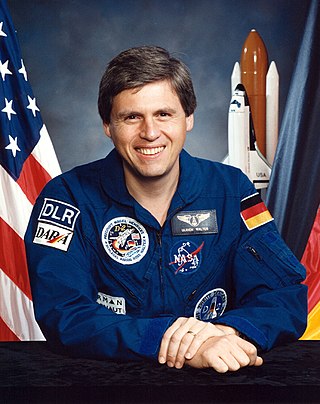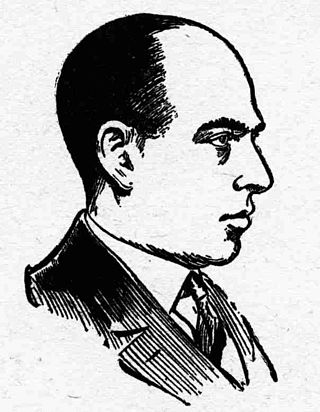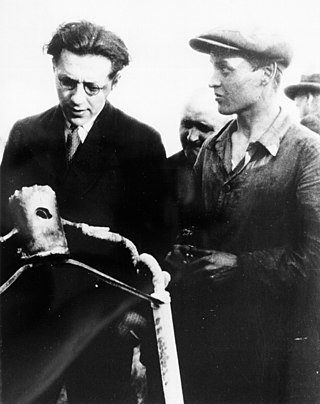
Hermann Julius Oberth was an Austro-Hungarian-born German physicist and rocket pioneer of Transylvanian Saxon descent. He is considered one of the founding fathers of rocketry and astronautics, along with Robert Esnault-Pelterie, Konstantin Tsiolkovsky, Robert H. Goddard and Herman Potočnik. Oberth supported Nazi Germany's war effort and received the War Merit Cross in 1943.

Ulrich Hans Walter is a German physicist, engineer and former DFVLR astronaut.

Max Valier was an Austrian rocketry pioneer. He was a leading figure in the world's first large-scale rocket program, Opel-RAK, and helped found the German Verein für Raumschiffahrt that would bring together many of the minds that would later make spaceflight a reality in the 20th century.

The Verein für Raumschiffahrt was a German amateur rocket association prior to World War II that included members outside Germany. The first successful VfR test firing with liquid fuel was conducted by Max Valier at the Heylandt Works on January 25, 1930; and additional rocket experiments were conducted at a farm near Bernstadt, Saxony.

Eugen Sänger was an Austrian aerospace engineer best known for his contributions to lifting body and ramjet technology.
Kumulus is the name of a rocket of the "Hermann-Oberth-Gesellschaft e.V.". The first Kumulus rocket was launched on December 20, 1960, near Cuxhaven. A Kumulus rocket is on display at the Hermann Oberth Space Travel Museum in Feucht.
The Hermann Oberth Gesellschaft (1952-1993) was an association named after Hermann Oberth, the German astronautics pioneer and the authoritative expert on rocketry outside the United States, which develops and builds rockets and trains engineers in space technology.
The Cirrus is a sounding rocket with two stages, developed by the "Hermann Oberth Society". Its only launches were both on September 16, 1961, at Cuxhaven. The maximum height of the Cirrus, depending on the version, is 35 kilometres with a single stage or 50 kilometres for the 2 stage version.
Gerhard Zucker (1908–1985) was a German businessman and rocket engineer.

Feucht is a market town and municipality southeast of Nuremberg in the district of Nürnberger Land in Bavaria, Germany. The name Feucht is derived from the Old High German noun "viuhtje" - "fichta", which is the spruce tree. As of 31 December 2019, Feucht had a population of 14,050. Hermann Oberth (1894–1989), one of the early fathers of space travel, lived for many years and died in Feucht.

Konrad Dannenberg was a German-American rocket pioneer and member of the German rocket team brought to the United States after World War II.
In astronautics, a powered flyby, or Oberth maneuver, is a maneuver in which a spacecraft falls into a gravitational well and then uses its engines to further accelerate as it is falling, thereby achieving additional speed. The resulting maneuver is a more efficient way to gain kinetic energy than applying the same impulse outside of a gravitational well. The gain in efficiency is explained by the Oberth effect, wherein the use of a reaction engine at higher speeds generates a greater change in mechanical energy than its use at lower speeds. In practical terms, this means that the most energy-efficient method for a spacecraft to burn its fuel is at the lowest possible orbital periapsis, when its orbital velocity is greatest. In some cases, it is even worth spending fuel on slowing the spacecraft into a gravity well to take advantage of the efficiencies of the Oberth effect. The maneuver and effect are named after the person who first described them in 1927, Hermann Oberth, a Transylvanian Saxon physicist and a founder of modern rocketry.
German Society for Aeronautics and Astronautics is a German aerospace society. It was founded in 1912 under the name of Wissenschaftliche Gesellschaft für Flugtechnik (WGF). It is the second oldest technical and scientific society in aerospace in the world.

Heinz-Hermann Koelle was a German aeronautical engineer who made the preliminary designs on the rocket that would emerge as the Saturn I. Closely associated with Wernher von Braun's team at the Army Ballistic Missile Agency (ABMA), he was a member of the launch crew on Explorer 1 and later directed the Marshall Space Flight Center's involvement in Project Apollo. In 1965, he accepted the Chair of Space Technology at the Technical University of Berlin.

Space mirrors are satellites that are designed to change the amount of solar radiation that impacts the Earth as a form of climate engineering. The concept was first theorised in 1923 by physicist Hermann Oberth and later developed in the 1980s by other scientists. Space mirrors can be used to increase or decrease the amount of solar energy that reaches a specific point of the earth for various purposes. They have been theorised as a method of solar geoengineering by creating a space sunshade to deflect sunlight and counter global warming.

Reinhold Tiling was a German engineer, pilot and a rocket pioneer.
Erna Roth-Oberth (born 27 February 1922 in Schäßburg, Transylvania; died 23 August 2012 in Feucht was a Transylvanian-German lawyer, a daughter of Hermann Oberth. From 1953, she worked as a lawyer, assisted her father in completing his business affairs and in publishing his works. In 1969, she co-founded the Salzburg International Space Agency, Hermann Oberth - Wernher von Braun in Salzburg, and was its vice president for many years. In 1971, together with her husband Josef Roth, she founded the Hermann Oberth Space Museum in Feucht near Nuremberg with the aim of illustrating the development of space technology.

Paul Ehmayr was a German-Austrian rocket engineer. He was a precision mechanic. His masterpiece was a barometer.

Pfinzing Castle or Mornek Castle is one of three preserved castles of the Nuremberg patriciate in Feucht, along with the Tucherschloss and the Zeidlerschloss. The Castle has been owned and used by the market town of Feucht since 1988. Concerts and art exhibitions are held in the entrance hall.
Wege zur Raumschiffahrt is a book by Hermann Oberth. Written in German, it was published in 1929 by the Munich Oldenbourg publishing house and was considered a standard work in rocketry for a long time. It was - with a new title and completely revised - the 3rd edition of Oberth's first book Die Rakete zu den Planetenräumen, published in 1923.













